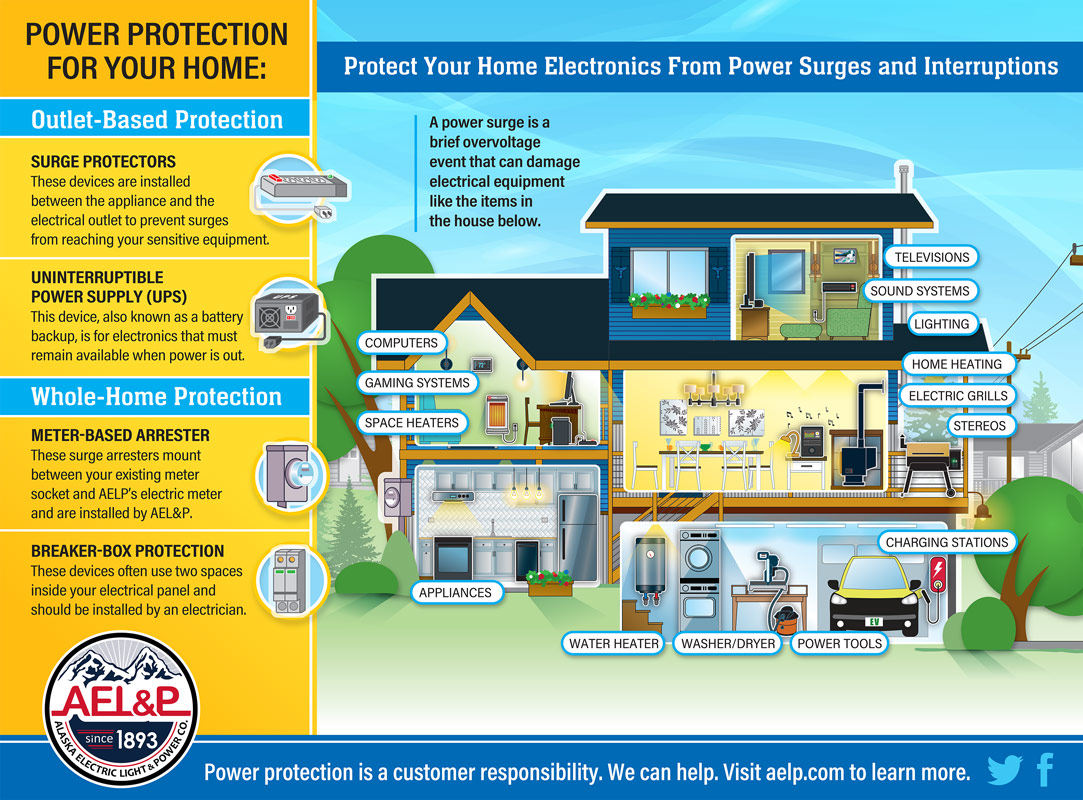Whole-home surge protection
Protect your home or business with a meter-mounted or panel-mounted surge protector. By having a surge protector installed at your main circuit panel or meter, you safeguard your home's entire electrical system. This includes wiring and appliances.
Below are two examples of whole-home protection.
- First Example Surge Protective Devices mount inside your home's main electric panel. These devices often use two spaces inside the panel and should be installed by an electrician. The devices themselves typically range between $50 and $175 depending on how they mount and the various features they offer.
- Second Example Meter Surge Arresters mount between your existing meter socket and AELP's electric meter. These devices typically range between $150 and $250 and can be purchased locally through most local electrical contractors. Once you have purchased the device and have it on hand, call AELP's main office at 907.759.5900, ask for the meter department, and schedule a time to have our meter department install the device for free.
Outlet-based surge protectors
These devices are installed between the appliance and the electrical outlet to prevent surges from reaching your sensitive equipment.
Uninterruptible Power Supply (UPS)
Use a UPS for office equipment and computer networks that must remain available.
A UPS protects computers, modems and other sensitive equipment by regulating voltage, guarding against surges, spikes, voltage sags and power outages that can cause your equipment to fail. In the event of a power outage or surge, a UPS automatically provides temporary emergency backup power from a battery. A UPS is an extra safety measure against power surges. A UPS is a relatively inexpensive way to provide backup power to computers and office equipment. UPS devices for home applications are 'plug and play' and easy to install yourself.
Wiring and Grounding
A few preventative measures can go a long way in protecting your home or business.
- Are your lights dimming or getting brighter? Is your electronic equipment acting unreliably? You may have problems with your wiring. Make sure the equipment is plugged into a grounded outlet, and have an electrician check your wiring.
- Living in an older home? Generally, houses built before 1960 do not have a ground conductor included with their electrical outlets. In other words, there are two holes instead of three. Occasionally, people add outlets to their house so they can plug in three-prong cords, but they do not add the ground wire to the receptacle. An electrical contractor can help.
- Check appliances for loose or damaged plugs or poor connections, and repair or replace them as needed.
Customer Responsibility
AEL&P continually makes system improvements designed to reduce the scope and duration of outages. However, since it is impossible to prevent all outages, voltage fluctuations and disturbances can occur.
AEL&P is not responsible for equipment damage caused by Mother Nature, normal operations, and equipment failure. Therefore, it is important that customers understand how to protect their electronics and appliances from electrical damage.
You are responsible for the safe-keeping of your equipment, including what's inside your home as well as equipment for your electrical service entrance, which you own. If you have overhead service, this includes the masthead to your meter base and on into your service panel. You are responsible for all connections inside the service panel as well as all safety grounding. It is imperative that you have adequate power protection for your appliances and electronics, such as surge suppressors. Call 907.759.5903 if you need ideas on how best to protect your appliances and equipment.
Electric Equipment: Who Owns What
Have questions?
Give our energy expert a call at 907.759.5903.
- Shopper's Guide to Home Power Protection brochure: (PDF)
